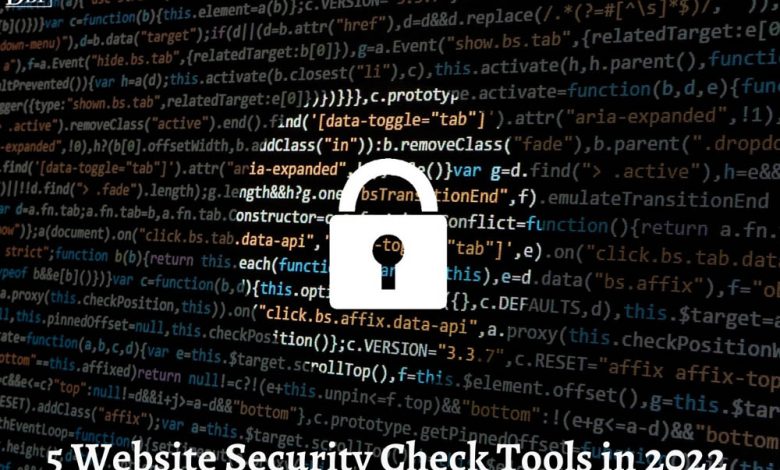12 Website Security Check Tools in 2022

Imagine that you have found an online shopping site and that it offers a product that interests you. It is also available at a low price, albeit for a limited time. You start to wonder if the offer is too good to be true… Or let’s say you are looking for free software. The search engine offers you links. However, there is something fishy about the URL. Would you risk losing money or compromising security? Probably not. Instead, you should learn how to check the website’s security-articlewine.
You can never be too careful online. There is no need to share vital personal information on platforms you don’t trust. Some sites try to imitate popular portals to get your login credentials. Is there a foolproof way to check a website’s reputation and avoid scammers?

Good news! There’s nothing complicated about checking a website’s reputation. And you’ll soon find out why.
Below, you will discover the best ways to verify the authenticity of an online portal. We will also introduce you to some useful tools for checking fraudulent websites. In this article, take a look at website security check tools in 2022.
Norton360 Deluxe –
Subscribe to Norton360 Deluxe and get 75GB cloud backups and protect up to 5 devices for $19.99 for the first year (local currency fee if based outside the US)! Click Here
The Internet is becoming increasingly dangerous for anyone concerned about data security. You can expose sensitive information and personal identification information in various ways. Especially nowadays, with more news 1.5 million phishing websites that make their way onto the Web each month.
The average cost of data breaches due to phishing reached a staggering $3.92 million in 2019. You should know that fraudulent websites are causing huge problems for individuals and businesses alike. Based on Wombat’s recent State of the Phish report, more than 76% of businesses in the U.S. have been victims of phishing attacks.
That’s why it’s essential to check the website security-articlewine of the website whenever a portal raises the slightest suspicion. How to ensure safe surfing on the Internet?
Here are some proven ways to check if you are on a secure website.
Configure a Web Browser
All popular browsers have website security tools by default. Just browse their security settings to activate them. You will find a variety of protection options.
Do you want to avoid the damage caused by fraudulent and scam sites? Then consider disabling pop-ups and automatic downloads, blocking webcam and microphone access, and disabling Flash content.
The majority of Google products (including Chrome) offer website security features to ensure the safest browsing experience. In addition, you can use secure web browsers like brave or AVG Secure Browser. Browsers like this have a built-in fake website checker. They also offer additional features such as ad blockers and various website security extensions.
Firewalls and Browser Extensions
Let’s not forget the basics. Remember that Windows, Linux, and Mac operating systems have built-in firewalls? Don’t underestimate their effectiveness. Keep them enabled when you’re roaming the uncharted reaches of the World Wide Web-articlewine.

It wouldn’t hurt to use additional website security solutions that inform you of the website’s reputation. There are also excellent antivirus and browser extensions that can check the website security of the website on the go.
Are you interested in learning more about them? Don’t worry. We’ll talk about it in a second.
Watch Out for the Signs
Imagine this: you enter a new site. An online shopping portal, for example. All your website security tools and extensions are silent. Is this website safe, then?
Don’t rely on it. You should never trust your website security entirely to software and online services. Follow your instincts and common sense. Does anything on this website annoy you?
Here are the basic signs you should pay attention to in order to verify the authenticity and website security.
- HTTP and HTTPS Does the site address start with HTTP or HTTPS? You might be wondering what the difference is. HyperText Transfer Protocol is the tool that exchanges data between the website and your browser. The “S” in HTTPS stands for “secure” and means that the portal uses an appropriate SSL certificate. If an online shopping site does not have proper encryption measures, there is no guarantee that your private information or payment credentials are safe.
- Padlock icon Most browsers indicate whether the portal is verified or not by the appearance of the address bar. Be careful if you see a red address bar or a badge indicating that the platform is “not secure”.
- URL itself Many fake websites contain spelling mistakes in their URLs. That’s because phishing sites try to fool you by replicating the addresses of popular services. For example, scammers replace or skip letters (g0ogle.com, paypai.com, b1ng.com) to trick you into entering your login details. In addition, it is atypical for shopping platforms to use .net and .org domains.
- Site Content Do you notice any spelling or grammatical errors on the pages? Are the images poorly resized or copied and pasted from the archive galleries? These are signs of obvious rush jobs and a bright red flag that this site is fake.
- Redirects, spam, pop-ups It’s pretty simple. A website bombards you with ads, pop-ups and tries to direct you to other portals? Consider a website security check completed and get out of there without hesitation.
- Brand Imitation No reputable supplier would sell replicas or duplicates of popular products. A close look at a product like this is more than enough to spot an imitation.
- Discount Timers Limited offers are one of the most manipulative methods designed to motivate people to convert. However, online scammers tend to abuse this method. And you can check it out with little effort. First, find out how many products have “limited offers” on that site. Then, visit the same URL from other devices and compare the remaining discount time for the same product.
- Legal Information It is wise to check contact information before making a purchase. Go to the “About Us” or “Contact Us” sections of a website. Note the full legal name of the business and the owner’s information. Now try calling using the phone numbers provided. No one answers or the number is not in service? We think you know what this means.
- Privacy policy Go to the “Privacy” section if you want a complete picture of the legitimacy of the site. It is usually located at the bottom of the home page. And it’s probably best to leave a site in case the privacy policy section can’t be found.
Website Security Check Tools
There are easier ways to check the website security. Link checkers are online tools that scan standard and shortened URLs. They alert you if they find potential ransomware or malware. Fake website checkers are also great for identifying phishing websites and online shopping scams in seconds. And we’re not exaggerating. Read on to find out how to check the reputation and legitimacy of a website on the go.
12 tools to check the website security and authenticity of a website Want to perform an accurate website security with a few clicks? These tools can help you check URL security to avoid online pitfalls.
1. WHOIS (ICANN domain search)
ICANNQUI EST allows you to view information about any domain. All you have to do is enter a URL and click on “Search”.

You will get information about the creation date, name servers, registry expiration date, as well as the unique domain ID. Want to know if this website is safe or not? Then we have good news for you. WHO IS displays site owners’ contact information (if publicly available) so you can double-check its legitimacy.
2. VirusTotal
VirusTotal is a free fake website checker that filters the portal through dozens of antivirus and blacklist services.

With this tool, you get instant reports on the website security. It offers a community score, which shows you whether registered users vouch for that portal. VirusTotal also offers comprehensive information about the site owners. And if that is not enough, this tool allows you to scan individual files for malware.
3. Google Transparency Report
Where would we be without Google? Google Transparency Report is a basic but effective link checking service tool. It can warn you about insecure website security that threaten your privacy.

Does something in the URL look suspicious? Is one of the offers on an online shopping platform too good a deal? This tool will let you know how dangerous it is.
4. TalosIntelligence
TalosIntelligence is a fantastic thread detection network and domain reputation center.

This tool scans websites for various threats. It provides a detailed report, which contains relevant information about the site history. TalosIntelligence also displays the reputation ranking, blacklist check results and domain information.
5. Kaspersky Virus Desk
Kaspersky is a reputable website security solution provider with over 30 years of impeccable experience. And it also has a fake website checker and a virus scanner. Just paste in an address of the domain in question and get results in a few moments. Plus, you can drag and drop suspicious files to scan for malware.

Kaspersky VirusDesk checks the reputation of the website and tells you whether the link is dangerous or malicious. But that’s not it. Kaspersky’s tool understands that ads can bombard you against your will. That’s why it displays URLs that have a lot of pop-ups and spam.
In addition, this website checker warns you if there is no data available on the portal. It’s up to you to decide if the visit is worth the risk.
6. Norton SafeWeb
Another fake website checker for a respected antivirus company. Norton Safe Web is a fairly simple link checker if you’ve been paying attention so far. Enter a URL, click “Enter” and you’ll get information about the safety of the website. This is also part of Norton 360 as standard.
The NortonLifeLock system compiles a report based on the reputation, website security and potential security issues of the portal. Apart from that, this tool has a community review section. You can read what others are saying about a website. This is useful if you want to avoid ad-heavy platforms.
But wait. That’s not all Norton has to offer to keep your web browsing safe! You might want to pay attention to the following two utilities if you’re a Google Chrome fan.

7. Norton Safe Search (Norton Chrome extension)
Want to avoid risky sites completely? You can do it with Norton’s Safe Web Chrome extensions. It’s available for free from the Chrome Web Store.
Norton Safe Web protects you from phishing sites and scams in every corner of the Internet. It does have one drawback, though. This tool makes Norton Safe Search your default search engine.
If this is not a problem for you, then you will certainly like this fraudulent websites checker. Safe Web informs you about dangerous shopping portals and offers a website security rating for each result while marking the most dangerous ones.
8. URLVoid
URLVoid is an incredibly popular fake website verification tool from APIVoid. It can scan any portal for malware and phishing threats using advanced software (including over 30 blacklist engines).
This tool provides a summary of the site, domain information and other publicly available data. URLVoid also provides detailed blacklist reports for each engine that scanned the website.

Do you like this website verification tool? Then feel free to try other APIVoid products like URL Reputation Checker and IP Address Scanner.
9. Sucuri
Found a potentially lousy website? Check the website security with Sucuri. It’s a free and comprehensive website security and malware scanner. They also offer premium services to website owners to secure their own sites as well.

Enter a website address and give it a few seconds. Sucuri scans portals for viruses, errors, spyware and suspicious code. This tool ranks the website security on a scale from “Minimal” to “Critical”.
As a reminder, you can contact the Sucuri team if you would like to perform an exhaustive analysis.
10. PhishTank
We have already been through several fake website detectors. PhishTank, on the other hand, focuses solely on protecting you from phishing sites. It’s a great free tool for those who want to secure their login credentials.
How does it work? PhishTank checks the URL in question through myriad blacklist engines and databases. You will receive immediate notification if it is a phishing link.

What if it’s not in any of the databases? In that case, this tool creates a tracking number to review that resource in the future.
11. ISIT phishing
Want to make sure you don’t enter a phishing site?
With ISITPhishing, you can be sure that your credit card information remains secure.
As you might expect, it’s just as easy as before. Copy the URL and click on
You can use the “Check” button to perform a quick scan of the website. This tool warns you if the link is compromised.
You may also like ISITPhishing as a widget. You don’t need to be a computer expert to implement it on your site. Just copy a generated code into the HTML code of your site. This way others can test URLs for phishing threats directly from your portal.
12. Desenmascarame
Online counterfeiters love to create big brand products. And brands love to Unmask Me for a large number of scammers it has exposed over the years. This fake website checker has detected over 61,000 fraudulent portals.
Desenmascara. I is an indispensable tool for those who love shopping. Want to avoid buying fake products? A few clicks are enough to check the authenticity of the portal and avoid potential scams.
Found a fraudulent or deceptive website? Report it!
We hope our article has helped you avoid risky and fake portals. But why not stop for a minute to help others?
Let’s say you’ve spotted a deceptive website with any of the scam checking techniques or tools we mentioned above. You shouldn’t rush into anything. Take your time to warn the rest of the Internet about it.
Don’t worry. It won’t take too long. You can do the following to report fraudulent or phishing websites:
- Contact an anti-phishing task force about phishing resources.
- Forward phishing emails to reportphishing@reportphishing.net.
- Notify the Cybercrime Complaint Center or Federal Trade Commission about fraudulent websites.
- Report the appropriate brand owners in case you find counterfeit products or fake online stores.
- Phishing and fraudulent portals can be reported to a national fraud reporting center.
Final thoughts
This is an appropriate time to be concerned about your private information. With over 1.5 million new fraudulent websites each month, you can never be too careful. It’s best to make it a rule to ask yourself, “Is this website safe?” before clicking on a new URL.
By now, you should know everything about how to check the website’s security. There are several proven methods to spot them manually. You can also use various free tools that we mentioned. Either way, your website security is in your hands. It only takes a few more clicks-articlewine.
Write For Us Sponsored Post-Articlewine






